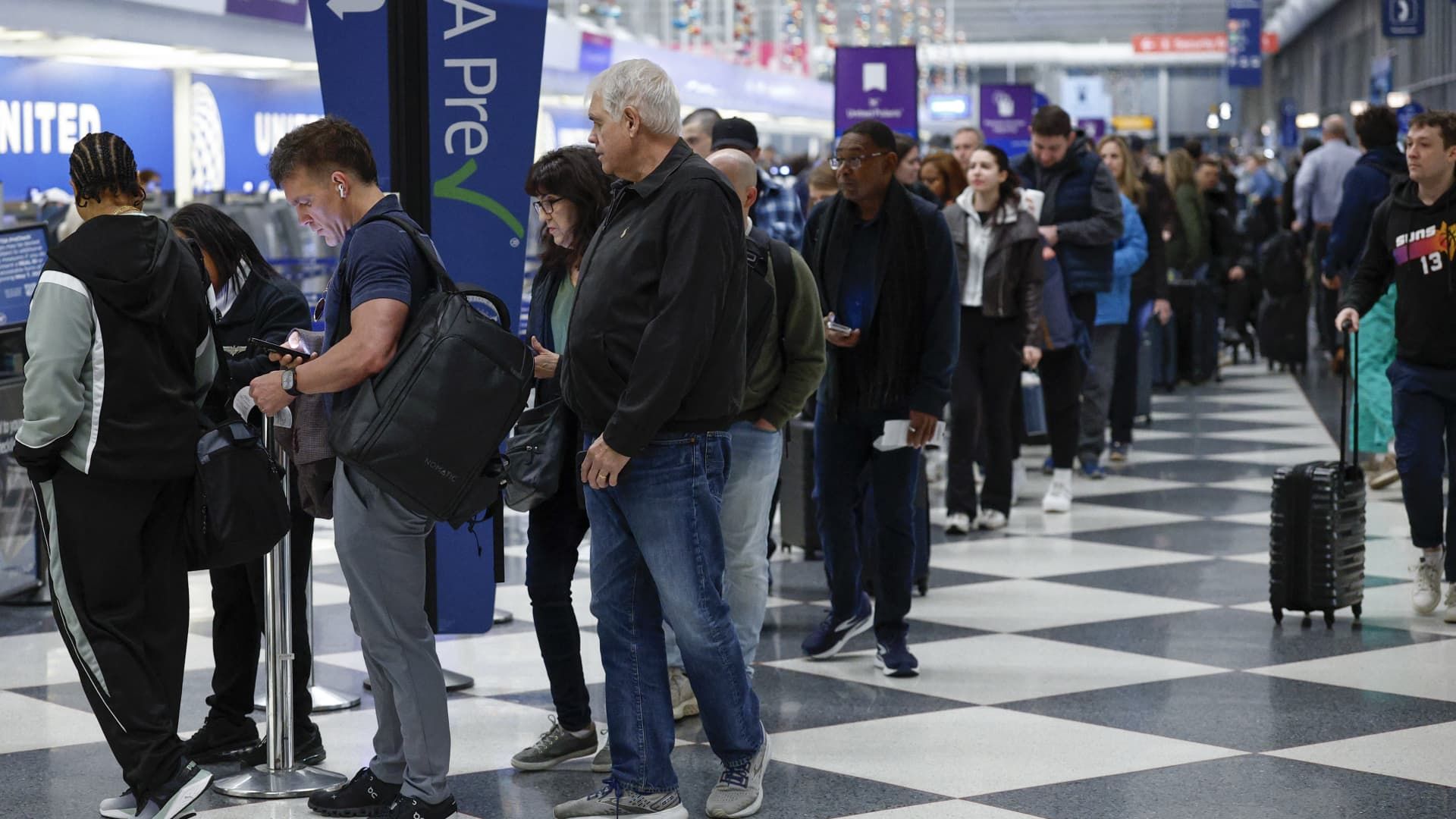U.S. airlines began canceling hundreds of flights on Friday, hours after the Federal Aviation Administration ordered the cuts amid a government shutdown that has now lasted more than a month.
The reductions were ordered because air traffic controllers did not receive their paychecks due to the government shutdown, now the longest in U.S. history. A shortage of air traffic control personnel has been disrupting flights at several major U.S. airports, upsetting travelers and airline executives alike.
On Friday night, Senate Republicans rejected a Democratic proposal to reopen the government.
A shortage of air traffic controllers was delaying flights at several major U.S. airports on Friday, including Newark Liberty International Airport in New Jersey, San Francisco International Airport and Hartsfield-Jackson International Airport in Atlanta.
This week's sudden flight cuts have forced airlines to scramble with schedule adjustments and make sure crews are where they need to be despite last-minute changes.
About 780 U.S. flights were canceled as of 2 p.m. ET on Friday, according to aviation data firm Cirium, about 3% of the day's total schedule. That scale of disruption is fairly common for routine outages like major thunderstorms, but the Transportation Department warned that cancellations could increase.
Travelers wait in line at a security checkpoint at O'Hare International Airport in Chicago, Illinois, on Nov. 7, 2025.
Kamil Krzaczynski | afp | fake images
Under the FAA order, flight cuts will increase to 10% over the next week, starting with 4% on Friday, 6% on Tuesday, 8% on Thursday and finally 10% on November 14.
Friday's cancellation levels were the 72nd worst for the U.S. flight market since Jan. 1, 2024, according to Cirium. That period also included a Southwest Airlines holiday crisis after severe weather conditions and massive delays in Delta Airlines last summer following a CrowdStrike technology outage.
While the FAA required airlines to make cuts, the general aviation sector, which includes private jets, was not required to make similarly extensive cuts. However, the order said staffing shortages could impact general aviation and those private flights could face cuts of up to 10% at airports the agency designated as “high impact,” including New Jersey's Teterboro Airport and Texas' William P. Hobby Airport in Houston and Dallas Love Field.
The FAA did not respond to requests for comment.
A spokesman for the National Business Aviation Association said the industry is also being affected by air traffic staffing shortages and reduced capacity, and that airports could deny some planes the ability to land there.
NBAA President and CEO Ed Bolen said, “Our industry will continue to pursue mandatory and voluntary means to ensure we are part of the solution to the challenges posed in the current environment.”
The financial impact of the latest disruptions is not immediately clear. The cancellations could help boost airlines' unit revenue as customers compete for fewer seats, “but we also believe the extended closure and widespread cancellations will impact booking demand in the near term,” Wolfe Research airline analyst Scott Group wrote in a note Friday.
The cuts come during a period of generally low travel demand before the Thanksgiving holiday, but still caused many travelers to look for alternatives. car rental company hertz said bookings in the past two days for one-way rentals were up more than 20% from the same period last year.
Major network airlines said the disruptions were largely focused on regional flights flying to smaller cities. united airlinesFor example, it said its hub-to-hub flights and long-haul international flights would not be canceled because of the order.
american airlinesFor its part, it said it was limiting disruptions to customers by avoiding cuts on routes where it only flies once or twice a day. Instead, the airline is cutting some daily flights from high-frequency markets, such as reducing daily departures between its hub at Dallas Fort Worth International Airport and Northwest Arkansas National Airport from 10 to eight, and Boston's Logan International Airport to Ronald Reagan Washington National Airport from 10 to nine.
The airline canceled 221 flights on Friday, according to CEO Robert Isom, who said the airline is “frustrated” with the reduction.
Isom said on CNBC's “Squawk Box” that the airline is working to ensure flights to all destinations continue to operate, but that the frequency of those flight routes is decreasing.
“What we've done today is try to minimize the impact on all of our customers – there are only 220 flights out of 6,200 flights – and we've done it in a way that really impacts our smaller aircraft,” Isom said. “This level of cancellation is going to grow over time and that is something that is going to be problematic.”

What passengers need to know
Airlines offered travelers alternative flights and waived change fees for affected customers.
Experts recommend staying aware of schedule changes by checking airline apps and websites, as well as reviewing travel insurance fine print.
AAA spokesperson Aixa Díaz said the company recommends arriving at the airport two hours early to avoid long lines and avoid checking in a suitcase as much as possible in the event of flight cancellation, although flexibility will be the most important thing for all travelers during this period.
Travel insurance experts warn that policies do not always offer blanket protection for closure-related changes and that refunds can often come down to the specific basis used by the airline to determine the cause of the delay or cancellation.
According to Lauren McCormick, a spokesperson for travel insurance platform Squaremouth, airlines sometimes fail to cite causes other than general delays, even during a closure, which could make it difficult to get a refund. Some credit cards offer travel insurance, but it is not a guarantee.
Here's where flights are expected to be reduced, according to the FAA and DOT order:
Airports impacted:
- ANC – Anchorage International
- ATL – Hartsfield-Jackson Atlanta International
- BOS – Boston Logan International
- ICM – Baltimore/Washington International
- CLT – Charlotte Douglas International
- CVG – Cincinnati/Northern Kentucky International
- DAL – Dallas Love
- DCA – Ronald Reagan Washington National
- DEN – Denver International
- DFW – Dallas/Fort Worth International
- DTW – Detroit Metropolitan Wayne County
- EWR – Freedom of Newark International
- FLL – Fort Lauderdale/Hollywood International
- HNL – Honolulu International
- HOU – Houston Hobby
- DIA – Washington Dulles International
- IAH – Intercontinental George Bush Houston
- IND – Indianapolis International
- JFK – New York John F. Kennedy International Airport
- LAS – Las Vegas McCarran International
- LAX – Los Angeles International
- LGA – New York LaGuardia
- MCO – Orlando International
- MDW – Chicago Midway
- MEM – Memphis International
- MIA – Miami International
- MSP – Minneapolis/St. Pablo International
- OAK – Oakland International
- ONT – Ontario International
- ORD – Chicago O'Hare International
- PDX – Portland International
- PHL – Philadelphia International
- PHX – Phoenix Sky Harbor International
- SAN – San Diego International
- SDF – Louisville International
- MAR – Seattle/Tacoma International
- OFS – San Francisco International
- SLC – Salt Lake City International
- TEB – Teterboro
- TPA – Tampa International
(Las Vegas airport was renamed Harry Reid International Airport in 2021.)
-CNBC Greg Iacurci contributed to this report.









